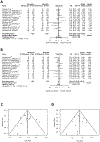Effect of Concomitant Therapy With Steroids and Tumor Necrosis Factor Antagonists for Induction of Remission in Patients With Crohn's Disease: A Systematic Review and Pooled Meta-analysis
- PMID: 32569749
- PMCID: PMC8364422
- DOI: 10.1016/j.cgh.2020.06.036
Effect of Concomitant Therapy With Steroids and Tumor Necrosis Factor Antagonists for Induction of Remission in Patients With Crohn's Disease: A Systematic Review and Pooled Meta-analysis
Abstract
Background & aims: It is not clear whether concomitant therapy with corticosteroids and anti-tumor necrosis factor (TNF) agents is more effective at inducing remission in patients with Crohn's disease (CD) than anti-TNF monotherapy. We aimed to determine whether patients with active CD receiving corticosteroids during induction therapy with anti-TNF agents had higher rates of clinical improvement than patients not receiving corticosteroids during induction therapy.
Methods: We systematically searched the MEDLINE, Embase, and CENTRAL databases, through January 20, 2016, for randomized trials of anti-TNF agents approved for treatment of CD and identified 14 trials (5 of adalimumab, 5 of certolizumab, and 4 of infliximab). We conducted a pooled meta-analysis of individual patient and aggregated data from these trials. We compared data from participants who continued oral corticosteroids during induction with anti-TNF therapy to those treated with anti-TNF agents alone. The endpoints were clinical remission (CD activity index [CDAI] scores <150) and clinical response (a decrease in CDAI of 100 points) at the end of induction (weeks 4-14 of treatment).
Results: We included 4354 patients who received induction therapy with anti-TNF agents, including 1653 [38.0%] who were receiving corticosteroids. The combination of corticosteroids and an anti-TNF agent induced clinical remission in 32.0% of patients, whereas anti-TNF monotherapy induced clinical remission in 35.5% of patients (odds ratio [OR], 0.93; 95% CI, 0.74-1.17). The combination of corticosteroids and an anti-TNF agent induced a clinical response in 42.7% of patients, whereas anti-TNF monotherapy induced a clinical response in 46.8% (OR 0.84; 95% CI, 0.73-0.96). These findings did not change with adjustment for baseline CDAI scores and concurrent use of immunomodulators.
Conclusions: Based on a meta-analysis of data from randomized trials of anti-TNF therapies in patients with active CD, patients receiving corticosteroids during induction therapy with anti-TNF agents did not have higher rates of clinical improvement compared with patients not receiving corticosteroids during induction therapy. Given these findings and the risks of corticosteroid use, clinicians should consider early weaning of corticosteroids during induction therapy with anti-TNF agents for patients with corticosteroid-refractory CD.
Keywords: Biologic; IBD; Inflammatory Bowel Diseases; RCT.
Copyright © 2021 AGA Institute. Published by Elsevier Inc. All rights reserved.
Figures


Comment in
-
What is the Real Impact of Corticosteroids in the Contemporary Treatment of Crohn's Disease?Clin Gastroenterol Hepatol. 2022 Feb;20(2):468-469. doi: 10.1016/j.cgh.2021.03.016. Epub 2021 Mar 13. Clin Gastroenterol Hepatol. 2022. PMID: 33727165 No abstract available.
-
Reply.Clin Gastroenterol Hepatol. 2022 Feb;20(2):469. doi: 10.1016/j.cgh.2021.04.010. Epub 2021 Apr 8. Clin Gastroenterol Hepatol. 2022. PMID: 33839279 No abstract available.
References
-
- Torres J, Mehandru S, Colombel JF, et al.Crohn’s disease. Lancet. 2017;389(10080):1741–55. Epub 2016/12/05. - PubMed
-
- Ford AC, Bernstein CN, Khan KJ, et al.Glucocorticosteroid therapy in inflammatory bowel disease: systematic review and meta-analysis. Am J Gastroenterol. 2011;106(4):590–9; quiz 600. Epub 2011/03/17. - PubMed
-
- Cohen BL, Sachar DB. Update on anti-tumor necrosis factor agents and other new drugs for inflammatory bowel disease. BMJ. 2017;357:j2505. Epub 2017/06/21. - PubMed
-
- Summers RW, Switz DM, Sessions JT Jr., et al.National Cooperative Crohn’s Disease Study: results of drug treatment. Gastroenterology. 1979;77(4 Pt 2):847–69. Epub 1979/10/01. - PubMed
-
- Yang YX, Lichtenstein GR. Corticosteroids in Crohn’s disease. Am J Gastroenterol. 2002;97(4):803–23. Epub 2002/05/11. - PubMed
Publication types
MeSH terms
Substances
Grants and funding
LinkOut - more resources
Full Text Sources
Other Literature Sources
Medical

